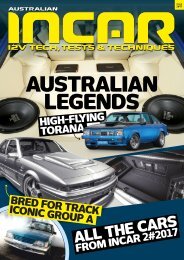New Hampshire Magazine September 2017
Create successful ePaper yourself
Turn your PDF publications into a flip-book with our unique Google optimized e-Paper software.
self. Like in a Jane Austen story, you could<br />
certainly see the potential for matchmaking. And<br />
indeed, contras have served as a kind of<br />
singles market for finding a mate throughout<br />
history. “Today if you went to any dance and<br />
asked how many people met their spouse at a<br />
dance, you’d find at least one couple at every<br />
dance,” says Millstone. “Typical contra dances<br />
are now smoke-, drug- and alcohol-free, so it’s<br />
a sort of crunchy granola alternative for people<br />
who don’t want to hang out in the bar or club<br />
scene necessarily. And the number of people<br />
who have met their spouse at a dance is legion.”<br />
And that’s not necessarily just for heterosexual<br />
couples, either. There’s a whole movement<br />
now to gender-free dancing, according to<br />
Millstone, where traditional roles are blurred.<br />
In cities like San Francisco and Boston, fans<br />
organize dances for the LGBT community.<br />
“Every 30 seconds you’re holding someone<br />
else in your arms, swinging, interacting, and it’s<br />
safe,” says Millstone. “It’s an opportunity to be<br />
physically connected to someone, you’re smiling<br />
a lot, making eye contact with people, and<br />
every so often along the way you might meet<br />
someone interesting. And that might turn into<br />
a spark that turns into something more.”<br />
But while it’s true that contra dancing is a<br />
cousin of Austen’s English country dancing<br />
and has its roots in 18th-century England, the<br />
people in this room more likely associate it<br />
with 20th-century <strong>New</strong> <strong>Hampshire</strong>.<br />
Contra in <strong>New</strong> England<br />
Bob McQuillen, a prolific composer of contra<br />
music from the 1940s on who received a<br />
National Heritage Fellowship, once referred<br />
to Nelson as the “contra dance capital of<br />
the world.” That’s a catchphrase that several<br />
Nelson dancers mentioned to me with pride.<br />
But while Nelson may have a colorful contra<br />
history dating back 200 years, it’s not necessarily<br />
the birthplace of the form.<br />
Above: Members of the Ralph Page Orchestra<br />
play in Nelson in 1941. Below from left:<br />
Samuel Foucher, Perrin Ellsworth-Heller,<br />
Roger Treat and Lloyd Carr<br />
What is clear is that contra is a descendant<br />
or cousin of English country dancing, according<br />
to Millstone. The first book that described<br />
English country dances was John Playford’s<br />
“The English Country Dancing Master,” published<br />
in 1651.<br />
“The first Playford’s had a lot of variations,<br />
including four-couple, three-couple<br />
and two-couple dances, and what they called<br />
‘long ways for as many as will,’ meaning long<br />
lines with men on one side and women on<br />
the other,” Millstone says. “The long lines<br />
dances were about a third of the repertoire in<br />
the first Playford. By the early 1700s, 98 percent<br />
of dances were ‘long ways for as many as will.’<br />
Those became the dances that the colonists from<br />
England brought to America.”<br />
Like other art, dance is impossible to<br />
separate from political events. By the time<br />
of the American Revolution, what started as<br />
English country dance had started to become<br />
less English. When America was allied with<br />
the French during the War of 1812, dance<br />
began picking up French influences, which<br />
would later evolve into quadrilles and squares.<br />
In <strong>New</strong> England, new 19th-century mills<br />
brought French Canadian workers and, with<br />
them, their styles of dance.<br />
“By the 1800s, something that we could call<br />
distinctly contra begins to develop in <strong>New</strong><br />
<strong>Hampshire</strong>,” says Millstone. “Political candidates<br />
in the late 1800s who wanted to garner<br />
favor with voters would host dances. Towns<br />
like Nelson and Francestown in the Monadnock<br />
Region have a long dancing tradition<br />
dating well back into [the] 1800s.”<br />
52 nhmagazine.com | <strong>September</strong> <strong>2017</strong>





